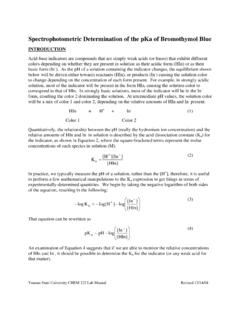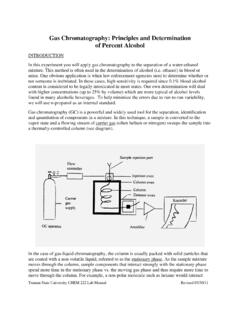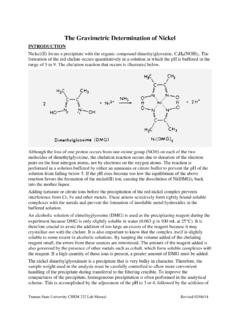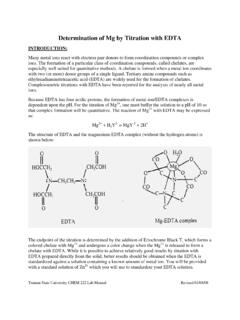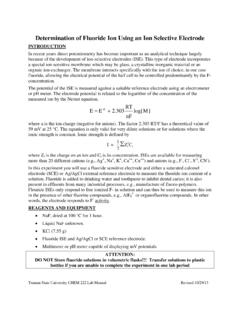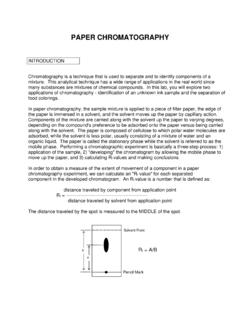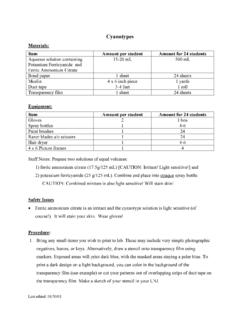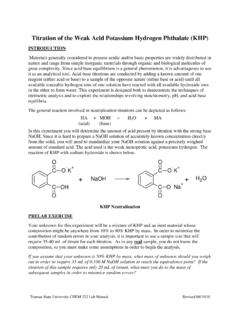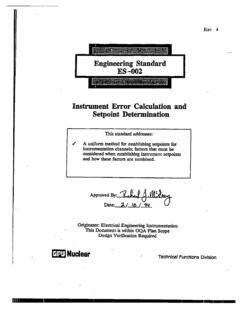Transcription of Spectrophotometric Determination of Iron
1 Truman State University CHEM 222 Lab Manual Revised 01/09/17 Spectrophotometric Determination of Iron INTRODUCTION Many investigations of chemical species involve the interaction between light and matter. One class of these investigations, called absorbance spectrophotometry, involves the transfer of energy from a photon of light to an analyte to produce an excited state species. By accounting for the quantity of light absorbed, the amount of analyte can be determined. Common analytical applications of spectrophotometry take advantage of the Beer-Lambert Law (often simply called Beer s Law) that relates the concentration of an analyte to its absorbance of monochromatic radiation as shown below: A = -log T = bc Where A is absorbance, T is transmittance, is a constant called the molar absorptivity, b is the path length through the sample, c is analyte concentration.
2 In practice, instruments monitor the transmittance of light by comparing the amount of light that leaves the light source, passes through the absorbing solution and strikes a detector (P) to the amount of light that strikes the detector when a non-absorbing solution is in the beam path (P0). The ratio of these responses is the transmittance (or percent transmittance). T PP0 or %T 100% x PP0 This ratio assumes that the response at the detector in the absence of any light is zero, which if often not the case. Most detectors have a nonzero response, even if no light is striking the detector, called the dark current (Pdark), which must be compensated for in order for the transmittance (and absorbance) value to be meaningful. T P PdarkP0 Pdark or %T 100% x P PdarkP0 Pdark Therefore, to make a useful measurement, the instrument must know three things (1) the response when no light strikes the detector (Pdark), (2) the response when a blank is in the beam path (P0), and (3) the response when the sample is in the beam path (P).
3 Ideally, Pdark and P0 are constant for a particular instrument under a particular set of conditions. Therefore, by measuring P at a single wavelength for a series of analyte solutions of known concentration and using P0 and Pdark to calculate the absorbance (or transmittance) it is possible prepare a calibration curve for the analyte response. The Spectronic 20 is an example of a direct-reading, single-beam spectrophotometer. By virtue of being direct-reading, spectrophotometers feature fast operation, and because of their simple design they are relatively inexpensive and require a minimum of maintenance. They are particularly well suited for Spectrophotometric determinations of a single component at a single wavelength where only moderate accuracy ( 1 to T) is required.
4 The Spec-20 has only three controls (1) an On/Off/0%T knob used to set zero percent transmittance when the sample chamber is empty, (2) a 100% T knob used to set 100 percent transmittance when a blank is in the sample chamber, and (3) a wavelength control used to set the desired wavelength for the Truman State University CHEM 222 Lab Manual Revised 01/09/17 measurement. Output on the Spec -20 is through an analog display that has both percent transmittance and absorbance scales. When recording data, it is wise to record both transmittance and absorbance values. The limitations of the single-beam instrument become apparent when an absorption spectrum over a wavelength range is required.
5 The response of the phototube, the emissivity of the light source, and the intensity of the light diffracted by the grating are all a function of wavelength. Accordingly, in order to obtain the absorption spectrum of a compound, the instrument must be recalibrated each time the wavelength setting is changed. The reaction between ferrous ion and 1,10-phenanthroline to form a red complex serves as a sensitive method for determining iron. Fe2+ + 3 phen Fe(phen)32+ NN 1,10 phenanthrolene (phen) The molar absorptivity of the complex, [(C12H8N2)3Fe]2+, is 11,100 at 508 nm. The intensity of the color is independent of pH in the range 2 to 9. The complex is very stable and the color intensity does not change appreciably over long periods of time. Beer's law is obeyed.
6 The iron must be in the ferrous state, and hence a reducing agent is added before the color is developed. Hydroxylamine, as its hydrochloride, can be used to reduce any ferric ion that is present: 2 Fe3+ + 2 NH2OH + 2 OH- 2 Fe2+ + N2 + 4 H2O The pH is adjusted to a value between 6 and 9 by addition of ammonia or sodium acetate. An excellent discussion of interferences and of applications of this method is given by Truman State University CHEM 222 Lab Manual Revised 01/09/17 HANDLING OF CUVETTES The handling of the cuvettes is extremely important. Often two cuvettes are used simultaneously, one for the "blank" solution and one for the samples to be measured. Yet any variation in the cuvette (such as a change in the cuvette width or curvature of the glass, stains, smudges, or scratches) will cause varying results.
7 Thus, it is essential to follow several rules in dealing with cuvettes: 1. Do not handle the lower portion of a cuvette through which the light beam will pass. 2. Always rinse the cuvette with several portions of the solution before taking a measurement. 3. Wipe off any liquid drops or smudges on the lower half of the cuvette with a clean Kimwipe (or other lens paper) before placing the the cuvette in the instrument. Never wipe the cuvette with paper towels or handkerchiefs. Inspect the cuvette to ensure that nor bubbles are clinging to the inside walls. 4. When inserting a cuvette into the sample holder: a. To avoid any possible scratching of the cuvette in the optical path, insert the cuvette with the index line facing toward the front of the instrument. b. After the cuvette is seated, line up the index lines exactly.
8 5. When using two cuvettes simultaneously, use one of the cuvettes always for the blank solution and the other for the various samples being measured. Mark the cuvette ( on the upper portion) accordingly and do not interchange the cuvettes during the remainder of the experiment. 6. Do not use a test tube brush to clean the cuvettes after the experiment is complete. REAGENTS 1,10-phenanthroline ( g of 1,10-phenanthroline monohydrate in 100 mL of distilled water, warming to effect solution if necessary). Hydroxylamine hydrochloride (10 g in 100 mL of distilled water). Sodium acetate (10 g in 100 mL of distilled water). Ferrous ammonium sulfate hexahydrate. SAMPLE PREPARATION 1. Weigh accurately about g of pure ferrous ammonium sulfate hexahydrate, dissolve it in water, and transfer the solution to a 1-liter volumetric flask.
9 Add mL of concentrated sulfuric acid and dilute the solution to the mark. Calculate the concentration of the solution in mg of iron per mL. (Remember, your solution was prepared using Fe(NH4)2(SO4)2 6H2O). 2. Prepare the unknown sample as follows. Add about g of the solid unknown and approximately mL concentrated sulfuric acid into a 100 mL volumetric flask and dilute to the mark. Now transfer a 1 mL aliquot of this solution to another 100 mL volumetric flask Truman State University CHEM 222 Lab Manual Revised 01/09/17 - do not dilute yet. This will be referred to as the "prepared unknown". 3. Into five 100 mL volumetric flasks, pipet (volumetrically) 1, 5, 10, 25, and 50 mL portions of the standard iron solution.
10 Put 50 mL of distilled water into another flask to serve as the blank. To each flask, including the "prepared unknown", add 1 mL of the hydroxylamine solution, 10 mL of the 1,10 phenanthroline solution and 8 mL of the sodium acetate solution. Then dilute all the solutions to the 100 mL marks and allow them to stand for 10 minutes with occasional shaking of the flasks. PART A -- Determination of Spectral Response of a Single-Beam Spectrophotometer The purpose of this section is to familiarize you with the Spectronic 20 operation and to illustrate the inherent impact of the performance of the light source and detector on a measurement. The light source in the Spectronic 20 is a type S-4 (cesium-antimony) phototube. The relative response of the phototube to a beam of monochromatic light of constant intensity is greatest near 400 nm and decreases fairly rapidly above 475 nm.
